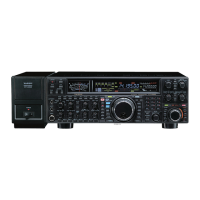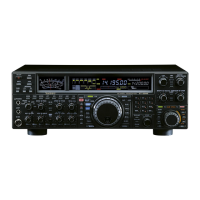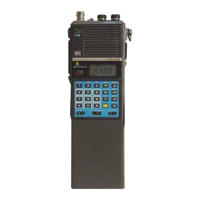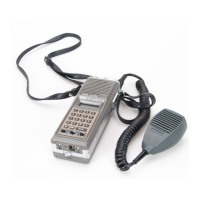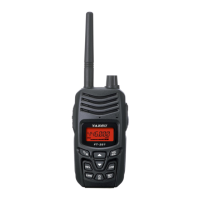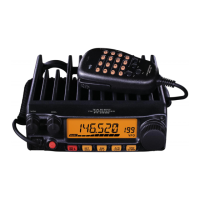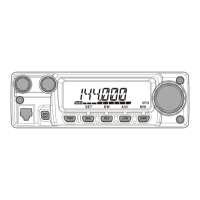Page 88 FT-2000D OPERATING MANUAL
CONTEST MEMORY KEYER
The FT-2000D in capable of the automatic sending of CW messages (as you might do in a contest). Two techniques for
message storage are available: you may either send the desired message contents using your keyer paddle (“Message
Memory”), or you may input the text characters using the Main Dial Tuning knob and
[
SUB VFO-B
]
knobs (“Text
Memory”).
Message Memory
Five memory channels capable of retaining 50 characters total are provided (using the PARIS standard for characters and
word length).
Example: CQ CQ CQ DE W6DXC K (19 characters)
--
•
--
•
-- --
•
-- --
•
--
•
-- --
•
-- --
•
--
•
-- --
•
-- --
•• •
•
-- -- --
••••
--
••
--
••
-- --
•
--
•
--
•
--
(
C
)
(
Q
)
(
C
)
(
Q
)
(
C
)
(
Q
)
(
D
)
(
E
)
(
W
)
(
6
)
(
D
)
(
X
)
(
C
)
(
K
)
CW CONVENIENCE FEATURES
S
TORING
A
M
ESSAGE
INTO
M
EMORY
1. Press the
[
MENU
]
button to enter the Menu mode.
2. Rotate the Main Tuning Dial knob to select the CW
Memory Register into which you wish to store the
message; for now, we are just selecting the message
entry technique (Keyer entry).
021 tEy CW MEM1
022 tEy CW MEM2
023 tEy CW MEM3
024 tEy CW MEM4
025 tEy CW MEM5
3. Rotate the
[
SUB VFO-B
]
knob to set the selected
Memory Register to “
tyP2tyP2
tyP2tyP2
tyP2.” If you want to use your
keyer paddle for message entry on all memories, set
all five Menu items (#021 ~ 025) to “
tyP2tyP2
tyP2tyP2
tyP2.”
4. Press and hold in the
[
MENU
]
button for two seconds
to save the new settings and exit.
M
ESSAGE
M
EMORY
P
ROGRAMMING
(
U
SING
YOUR
P
ADDLE
)
1. Set the operating mode to CW.
2. Set the
[
BK-IN
]
button to Off.
3. Turn the internal Electronic Keyer On by pressing the
[
KEYER
]
button, if necessary.
4. Press the
[
F5
(
MEM
)]
button on the front panel.
5. Press the
[
F1
(
CH1
)]
~
[
F4
(
CH-4
)]
button to begin
the memory storage process.
6. Send the desired message using your keyer paddle.
7. Press the
[
F5
(
MEM
)]
button once more at the end of
your message. Up to 50 characters may be stored among
the five memories.
NOTE:
You must exercise care in sending to ensure that the spaces
between letters and words are accurately done; if your tim-
ing is off, the spacing may not come out right in the stored
message.
For ease in setting up the keyer memories, we recommend
you set Menu item “054 A1A F-TYPE” and/or “056 A1A
R-TYPE” to “
ACSACS
ACSACS
ACS” (Automatic Character Spacing) while
you are programming the keyer memories.
Main Tuning Dial Knob
[
SUB VFO-B
]
Knob
[
MENU
]
Button
TERMINOLOGY:
PARIS Word Length: By convention in the Amateur
industry (utilized by ARRL and others), the length of one
“word” of CW is defined as the length of the Morse Code
characters spelling the word “PARIS.” This character (dot/
dash/space) length is used for the rigorous definition of
code speed in “words per minute.”
[
F1
(
CH-1
)]
~
[
F4
(
CH-4
)]
Button
[
F5
(
MEM
)]
Button
[
BK-IN
]
Button
[
KEYER
]
Button
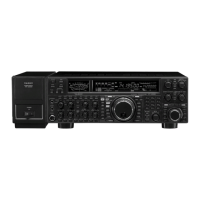
